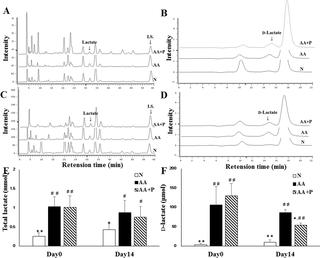Our official English website, www.x-mol.net, welcomes your
feedback! (Note: you will need to create a separate account there.)
Effect of prednisolone on glyoxalase 1 in an inbred mouse model of aristolochic acid nephropathy using a proteomics method with fluorogenic derivatization-liquid chromatography-tandem mass spectrometry.
PLOS ONE ( IF 2.9 ) Pub Date : 2020-01-22 , DOI: 10.1371/journal.pone.0227838 Shih‐Ming Chen , Chia‐En Lin , Hung-Hsiang Chen , Yu-Fan Cheng , Hui-Wen Cheng , Kazuhiro Imai
PLOS ONE ( IF 2.9 ) Pub Date : 2020-01-22 , DOI: 10.1371/journal.pone.0227838 Shih‐Ming Chen , Chia‐En Lin , Hung-Hsiang Chen , Yu-Fan Cheng , Hui-Wen Cheng , Kazuhiro Imai

|
Prednisolone is involved in glucose homeostasis and has been used for treatment for aristolochic acid (AA) nephropathy (AAN), but its effect on glycolysis in kidney has not yet been clarified. This study aims to investigate the effect in terms of altered proteins after prednisolone treatment in a mice model of AAN using a proteomics technique. The six-week C3H/He female mice were administrated AA (0.5 mg/kg/day) for 56 days. AA+P group mice were then given prednisolone (2 mg/kg/day) via oral gavage for the next 14 days, and AA group mice were fed water instead. The tubulointerstitial damage was improved after prednisolone treatment comparing to that of AA group. Kidney homogenates were harvested to perform the proteomics analysis with fluorogenic derivatization-liquid chromatography-tandem mass spectrometry method (FD-LC-MS/MS). On the other hand, urinary methylglyoxal and D-lactate levels were determined by high performance liquid chromatography with fluorescence detection. There were 47 altered peaks and 39 corresponding proteins on day 14 among the groups, and the glycolysis-related proteins, especially glyoxalase 1 (GLO1), fructose-bisphosphate aldolase B (aldolase B), and triosephosphate isomerase (TPI), decreased in the AA+P group. Meanwhile, prednisolone decreased the urinary amount of methylglyoxal (AA+P: 2.004 ± 0.301 μg vs. AA: 2.741 ± 0.630 μg, p < 0.05), which was accompanied with decrease in urinary amount of D-lactate (AA+P: 54.07 ± 5.45 μmol vs. AA: 86.09 ± 8.44 μmol, p < 0.05). Prednisolone thus alleviated inflammation and interstitial renal fibrosis. The renal protective mechanism might be associated with down-regulation of GLO1 via reducing the contents of methylglyoxal derived from glycolysis. With the aid of proteomics analysis and the determination of methylglyoxal and its metabolite-D-lactate, we have demonstrated for the first time the biochemical efficacy of prednisolone, and urinary methylglyoxal and its metabolite-D-lactate might be potential biomarkers for AAN.
中文翻译:

泼尼松龙对马兜铃酸肾病近交小鼠模型中乙二醛酶1的影响,采用蛋白质组学方法,采用荧光衍生化-液相色谱-串联质谱法。
泼尼松龙与葡萄糖稳态有关,已被用于治疗马兜铃酸(AA)肾病(AAN),但尚未阐明其对肾脏糖酵解的作用。这项研究的目的是使用蛋白质组学技术研究泼尼松龙对AAN小鼠模型治疗后蛋白质改变的影响。给六周的C3H / He雌性小鼠AA(0.5 mg / kg /天)给药56天。然后在接下来的14天中,通过口服强饲法给AA + P组小鼠泼尼松龙(2 mg / kg /天),然后给AA组小鼠喂水。泼尼松龙治疗后肾小管间质损害较AA组有所改善。收获肾脏匀浆,用荧光衍生化-液相色谱-串联质谱法(FD-LC-MS / MS)进行蛋白质组学分析。另一方面,尿液中的甲基乙二醛和D-乳酸水平通过高效液相色谱-荧光检测法测定。各组之间在第14天有47个改变的峰和39个相应的蛋白质,与糖酵解相关的蛋白质,特别是乙二醛酶1(GLO1),果糖-双磷酸醛缩醛糖醛缩酶B(醛缩酶B)和甘油三糖磷酸异构酶(TPI)减少。 AA + P组。同时,泼尼松龙降低了甲基乙二醛的尿量(AA + P:2.004±0.301μgvs.AA:2.741±0.630μg,p <0.05),同时尿中D-乳酸盐的量减少了(AA + P:54.07与AA相比±±5.45μmol,86.09±8.44μmol,p <0.05)。泼尼松龙因此减轻了炎症和间质性肾纤维化。肾脏保护机制可能通过降低糖酵解产生的甲基乙二醛含量而与GLO1的下调有关。借助蛋白质组学分析和甲基乙二醛及其代谢物D-乳酸盐的测定,我们首次证明了泼尼松龙的生化功效,尿甲基乙二醛及其代谢物D-乳酸盐可能是AAN的潜在生物标志物。
更新日期:2020-01-23
中文翻译:

泼尼松龙对马兜铃酸肾病近交小鼠模型中乙二醛酶1的影响,采用蛋白质组学方法,采用荧光衍生化-液相色谱-串联质谱法。
泼尼松龙与葡萄糖稳态有关,已被用于治疗马兜铃酸(AA)肾病(AAN),但尚未阐明其对肾脏糖酵解的作用。这项研究的目的是使用蛋白质组学技术研究泼尼松龙对AAN小鼠模型治疗后蛋白质改变的影响。给六周的C3H / He雌性小鼠AA(0.5 mg / kg /天)给药56天。然后在接下来的14天中,通过口服强饲法给AA + P组小鼠泼尼松龙(2 mg / kg /天),然后给AA组小鼠喂水。泼尼松龙治疗后肾小管间质损害较AA组有所改善。收获肾脏匀浆,用荧光衍生化-液相色谱-串联质谱法(FD-LC-MS / MS)进行蛋白质组学分析。另一方面,尿液中的甲基乙二醛和D-乳酸水平通过高效液相色谱-荧光检测法测定。各组之间在第14天有47个改变的峰和39个相应的蛋白质,与糖酵解相关的蛋白质,特别是乙二醛酶1(GLO1),果糖-双磷酸醛缩醛糖醛缩酶B(醛缩酶B)和甘油三糖磷酸异构酶(TPI)减少。 AA + P组。同时,泼尼松龙降低了甲基乙二醛的尿量(AA + P:2.004±0.301μgvs.AA:2.741±0.630μg,p <0.05),同时尿中D-乳酸盐的量减少了(AA + P:54.07与AA相比±±5.45μmol,86.09±8.44μmol,p <0.05)。泼尼松龙因此减轻了炎症和间质性肾纤维化。肾脏保护机制可能通过降低糖酵解产生的甲基乙二醛含量而与GLO1的下调有关。借助蛋白质组学分析和甲基乙二醛及其代谢物D-乳酸盐的测定,我们首次证明了泼尼松龙的生化功效,尿甲基乙二醛及其代谢物D-乳酸盐可能是AAN的潜在生物标志物。











































 京公网安备 11010802027423号
京公网安备 11010802027423号